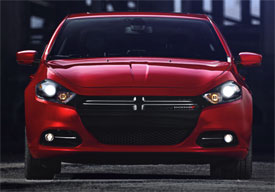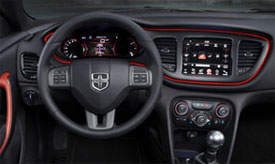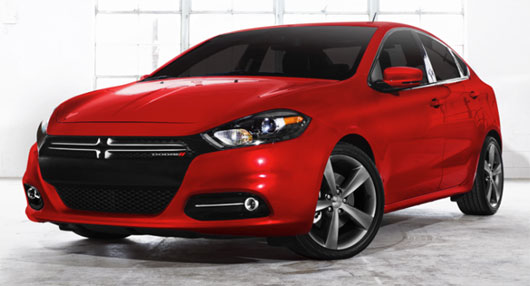2013 Dodge Dart
We always get a little nervous when we hear a classic car name making a return, especially when it’s attached to a small car. Well, the name is Dodge Dart, and it’s on Chrysler’s new Alfa Romeo-based compact. But, for those of you that don’t have fond memories of the original, the new Dart looks to be packing lots of high style and high tech features. So, let’s see if the Dart is another bulls-eye for Chrysler.
With the help of Fiat, Chrysler Group has been on a roll since emerging from bankruptcy. But, one thing that’s been missing from their line-up for nearly a decade is a viable compact sedan. Well, the 2013 Dodge Dart is a compact sedan and our first impression is that it’s way more than just viable.
Styling is certainly fresh, as the Dart joins the Hyundai Elantra as one of the most dynamic looking sedans in its segment. With its wide front end, and upsweeping side lines the Dart has a very athletic appearance, like a sprinter at the starting block. Sheet metal is taut and it indeed looks very European.
There is still the trademark Dodge crosshair grille, but it’s small and flat, with the front end more dominated by the large lower air opening. And, as is all the rage these days, active grille shutters are present, as is a full underbody aero treatment. The rear end is dominated by the Charger-inspired “racetrack” ring of LED’s, which unfortunately don’t come with all models, nor does dual exhaust. Under the Dart’s sharply creased hood, lies one of three engine choices ranging from the 1.4-liter turbo from the Fiat 500 Abarth to 2 and 2.4-liter normally aspirated I4’s.
 We’ve tried both the 1.4 and the 2-liter, and the 1.4 turbo is easily the more entertaining choice, even though it’s not as peppy here as in the much lighter Abarth. The exhaust is also muted although it still burps and pops like a classic Italian mill. The 2-liter Tigershark I4 is the standard engine on all but the R/T model and puts out the same 160-horsepower as the turbo, but far less torque at 148 pound feet.
We’ve tried both the 1.4 and the 2-liter, and the 1.4 turbo is easily the more entertaining choice, even though it’s not as peppy here as in the much lighter Abarth. The exhaust is also muted although it still burps and pops like a classic Italian mill. The 2-liter Tigershark I4 is the standard engine on all but the R/T model and puts out the same 160-horsepower as the turbo, but far less torque at 148 pound feet.
But, it was the 1.4 Turbo we took to our track. With the standard 6-speed manual, our 3,200 pound Dart managed a respectable 0-60 run of 8.2-seconds. However, it does feel faster. It takes a second for all 184 pound feet of torque to kick in, but off-the-line grunt is sufficient. Still, the ¼ mile was leisurely at 16.2-seconds and 87 miles-per-hour. A 6-speed Dual Dry Clutch automatic transmission is also available with the 1.4-turbo, while in the 2-liter you can opt for a traditional 6-speed automatic.
As the Dart is based on the Alfa Romeo Giulietta, we were expecting an entertaining trip through the cones, and we weren’t disappointed. This is the first Chrysler product with electric power steering and we found it quick and very well weighted, with a tight feel. There is a nice thick-rimmed steering wheel to play with too. When pushed hard, the Dart’s rear end lightens up just enough to have some fun and scoot through here with ease.
Brakes are a little grabby, but worked well enough to halt the Dart from 60 in a short 126-feet.
The Dart is bigger than the Giulitetta in every exterior dimension, which means plenty of room inside the great looking interior. Most materials are soft to the touch, but there are some lingering hard plastics on the doors and lower dash. There is an unusual pattern for the speaker and defrost grilles. Some like it, others thought it looked cheap. Front seating however, is top notch for a compact, and even back seat riders get deep cushioning and respectable leg room. Headroom is only an issue if you’re over 6-foot tall.
 The Dart trumps other compacts with lots of high tech features like a configurable Thin Film Transistor gauge panel, available heated steering wheel and keyless entry, a huge touch screen navigation system and an enormous glove-box, as well as under-seat storage up front. 10-airbags are standard.
The Dart trumps other compacts with lots of high tech features like a configurable Thin Film Transistor gauge panel, available heated steering wheel and keyless entry, a huge touch screen navigation system and an enormous glove-box, as well as under-seat storage up front. 10-airbags are standard.
On the road, the Dart also reacts solidly for a price-point compact car. Our 1.4 turbo has great Government Fuel Economy Ratings of 27-City and 39-Highway with the manual. We averaged a fine 28 miles-per-gallon of Premium. The 2-liter is a bit less efficient but runs on regular grade. The Energy Impact Score for the 1.4-liter is a fine 10.3-barrels of annual oil consumption with CO2 emissions of 4.6-tons. Ultimately there will be 5 trim levels of Dart, starting with the SE and a base price of $16,790.
As the first all-new car developed under Fiat leadership and Chrysler’s re-entry into the compact sedan segment, a lot is resting on the 2013 Dodge Dart’s well sculpted shoulders. And it joins the Ford Focus and Chevrolet Cruze as compelling reasons why consumers can finally consider domestic compact cars as true rivals to Civic and Elantra. The 2013 Dodge Dart does indeed hit the bull’s-eye… dead center.
Specifications
- Engine: 1.4-liter turbo
- Horsepower: 160
- Torque: 184 lb-ft.
- 0-60 mph: 8.2 seconds
- 1/4 mile: 16.2 seconds @ 87 mph
- EPA: 27 mpg city/ 39 mpg highway
- Energy Impact: 10.3 barrels oil/yr
- CO2 Emissions: 4.6 tons/yr
2024 Polestar 2
More Range And More Power For The Polestar 2
Volvo is well on their way to making the transition to an all-electric brand, but their sister-brand Polestar is already there. Now, we’ve spent lots of time in their all-wheel drive, five-door Polestar 2, having tested it in 2021, and a year later when a two-wheel drive version arrived. But, EV updates are coming quickly. So, let us be your guide for all that’s new with the Polestar 2.
While we are driving more EVs than ever, we’ve also been spending a lot of time recently circling back to ones we’ve previously tested. As in this new era of electrified vehicles, significant updates are arriving quickly, with R&D investments increasing and retrofitting them easier than ever. This is often done through software updates that can even be accomplished over the air. For 2024, the Polestar 2 has indeed gotten some software updates, but some physical ones as well.
Clearly aimed directly at Tesla’s Model 3 when it arrived; the Polestar 2’s build quality was vastly better, but range definitely came up short. So, addressing that was priority No. 1; and for ’24 the Polestar can travel up to 20% farther than before while consuming 9% less energy, and when it comes time to charge it back up, it can do that 34% faster too.
Range in the Single Motor version increases from a max of 270 to 320 miles thanks to a larger 82-kWh battery pack, and that solitary motor now powers the rear wheels, not the front wheels. It’s also bigger, coming in at 220 kW compared to the previous 170 kW front-wheel drive version, going from 231 to 299 horsepower.
Dual Motors keep the same 78-kWh battery, but still sees a boost from 260 to 276 miles and takes advantage of the larger rear motor for a new combined 310-kW output with 421 horsepower. Our test car has the added Performance Pack, which uses an additional 35 kW to deliver 455 horsepower and 546 lb-ft of torque, though max range drops to just 247 miles.
The new battery in rear-drive 2s will also charge faster, now accepting up to 205 kW for an 80% charge in 20 minutes; max for dual-motors stays at 155 kW, which puts an 80% charge at 34 minutes. Using 32 kWh of electricity per 100 miles, the Dual Motor earns a good efficiency rating.
The [Polestar] 2 has always been one of the most enjoyable EVs to drive, even more so now with that additional power coming from the rear motor.
Unfortunately, extremely cold temperatures kept us from seeing that increased range, as we were only on pace for about 194 miles in our test.
The 2 has always been one of the most enjoyable EVs to drive, even more so now with that additional power coming from the rear motor. And especially when equipped with the Performance Pack as it not only includes more power, but adds 20-inch forged wheels, upgraded brakes, and adjustable Ohlins Dual Flow Valve performance dampers. It greatly improves handling prowess without affecting ride quality, and is easily worth the $5,500 charge if you at all enjoy driving.
Even on a 20-degree track day there was plenty of grip through our handling course. No understeer or oversteer, and lots of feedback through the wheel. There was a nice, strong launch off the line that properly planted us firmly in the seat, and rocketed us to 60 in 4.5 seconds. Power delivery stayed pretty intense up until about 80 mph when there was a definite tapering off. Still, it was a 13.4-second quarter-mile at 102 mph; smooth, quiet, and stable the whole way.
When this car debuted, its Google-based infotainment setup was a novelty, but since then, more and more manufacturers are just “Googling it” so it doesn’t seem out of place at all. The wireless phone charger is easy to access, and there’s a great Harmon/Kardon sound system and panoramic sunroof to enhance the in-cabin experience. Exteriors have also been enhanced with a smooth grille insert and new wheel choices.
Hatchback practicality means 14.3 cu-ft of easy to access cargo space with split-folding seatbacks for longer items and expanding the space to 38.7 cu-ft. Plus, there’s even a sizeable storage bin up front under the hood.
Single Motor Polestar 2 pricing now starts at $51,300, with Dual Motors starting at $56,700; topping out at $64,400.
For a car manufacturer that hasn’t even been around for a decade yet, Polestar has kept itself busy, totally transforming their latest model in just a few years, making the 2024 Polestar 2 even more appealing. They are certainly off to a good start, and with a host of Polestars just over the horizon, including some all-important utility vehicles, this star will be shining even brighter.
Specifications
As Tested
- Motor Setup: Dual Motor
- Horsepower: 455
- 0-60 mph: 4.5 seconds
- EPA Range: 247 miles
- Efficiency : 32 kWh / 100 miles
- Battery Size: 78-kWh
- Torque: 546 lb-ft
- 1/4 Mile: 13.4 seconds at 102 mph
- MW Test Loop: ~ 194 miles
- Peak Charging Rate: 155 kW











































